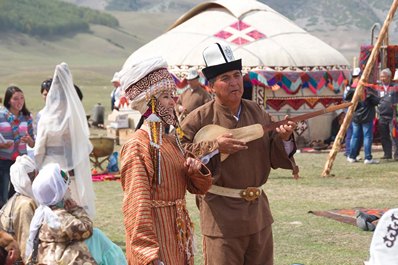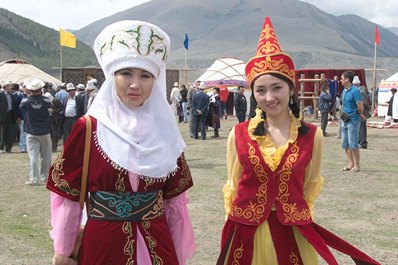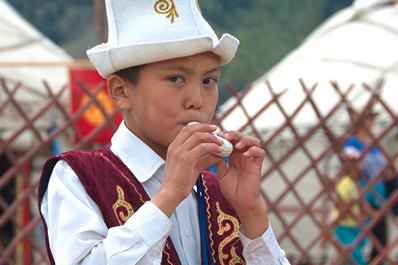Kyrgyz clothing reflects the lifestyle and regions of Kyrgyzstan, and the rich culture with designs and materials drawn from nomadic life. Wool, felt, leather, skins, and coarse cloth are the main materials used for Kyrgyz clothing, with ornamentation taken from tribal traditions and nature. Even though many people wear Western clothing, traditional elements are still visible everywhere, and people are proud of their traditional clothing in Kyrgyzstan.
The kalpak is perhaps the most famous item of clothing in Kyrgyzstan. A tall hat, made of white felt, it is usually worn by men after the age of 6. Men also wore a chapan, a coat with a high collar, and suede or leather trousers. Sometimes honored guests are presented with an intricately embroidered kalpak and long embroidered felt coat, called a chepken.
Women often wore a beldemchi, a skirt with a slit in the front, over a basic dressing gown or dress. For ceremonial occasions, dresses with ruffles on the sleeves and skirt are the most common, worn with embroidered vests and conical hats with feathers in the top (called shokulo). A large headdress made of up to 30 m (100 feet) of intricately wrapped fabric, called an elechek, was traditionally worn by women, and is still popular for ceremonies and festivals today. The elechek was prominently featured in the 2014 film Kurmanjan Datka, when it was a prominent part of women’s lives.
While nowadays clothing is much more Western than traditional, visitors should still be conscious of cultural difference regarding dress. In Bishkek, anything can be worn without attracting attention, but in Osh and in villages, visitors should dress more conservatively to avoid drawing unwanted attention.




